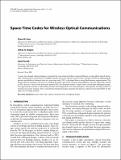| dc.contributor.author | Haas, Shane M. | |
| dc.contributor.author | Shapiro, Jeffrey H. | |
| dc.contributor.author | Tarokh, Vahid | |
| dc.date.accessioned | 2011-10-17T16:17:39Z | |
| dc.date.available | 2011-10-17T16:17:39Z | |
| dc.date.issued | 2002-03 | |
| dc.date.submitted | 2001-06 | |
| dc.identifier.issn | 1687-0433 | |
| dc.identifier.issn | 1110-8657 | |
| dc.identifier.uri | http://hdl.handle.net/1721.1/66286 | |
| dc.description.abstract | A space-time channel coding technique is presented for overcoming turbulence-induced fading in an atmospheric optical heterodyne communication system that uses multiple transmit and receive apertures. In particular, a design criterion for minimizing the pairwise probability of codeword error in a space-time code (STC) is developed from a central limit theorem approximation. This design criterion maximizes the mean-to-standard-deviation ratio of the received energy difference between codewords. It leads to STCs that are a subset of the previously reported STCs for Rayleigh channels, namely those created from orthogonal designs. This approach also extends to other fading channels with independent, zero-mean path gains. Consequently, for large numbers of transmit and receive antennas, STCs created from orthogonal designs minimize the pairwise codeword error probability for this larger class of fading channels. | en_US |
| dc.description.sponsorship | United States. Defense Advanced Research Projects Agency (Grant MDA972-00-1-0012) | en_US |
| dc.publisher | Hindawi Pub. Corp. | en_US |
| dc.relation.isversionof | http://dx.doi.org/10.1155/S1110865702000604 | en_US |
| dc.rights | Creative Commons Attribution | en_US |
| dc.rights.uri | http://creativecommons.org/licenses/by/3.0/ | en_US |
| dc.source | Hindawi | en_US |
| dc.title | Space-Time Codes for Wireless Optical Communications | en_US |
| dc.type | Article | en_US |
| dc.identifier.citation | Haas, Shane M., Jeffrey H. Shapiro, Vahid Tarokh. "Space-Time Codes for Wireless Optical Communications." EURASIP Journal on Advances in Signal Processing. 2002 Mar 18;2002(3):478950. | en_US |
| dc.contributor.department | Massachusetts Institute of Technology. Laboratory for Information and Decision Systems | en_US |
| dc.contributor.department | Massachusetts Institute of Technology. Research Laboratory of Electronics | en_US |
| dc.contributor.approver | Shapiro, Jeffrey H. | |
| dc.contributor.mitauthor | Shapiro, Jeffrey H. | |
| dc.contributor.mitauthor | Haas, Shane M. | |
| dc.contributor.mitauthor | Tarokh, Vahid | |
| dc.relation.journal | EURASIP Journal on Applied Signal Processing | en_US |
| dc.eprint.version | Author's final manuscript | en_US |
| dc.type.uri | http://purl.org/eprint/type/JournalArticle | en_US |
| eprint.status | http://purl.org/eprint/status/PeerReviewed | en_US |
| dc.date.updated | 2011-10-14T15:08:35Z | |
| dc.language.rfc3066 | en | |
| dc.rights.holder | et al.; licensee BioMed Central Ltd. | |
| dspace.orderedauthors | Haas, Shane M.; Shapiro, Jeffrey H.; Tarokh, Vahid | en |
| dc.identifier.orcid | https://orcid.org/0000-0002-6094-5861 | |
| mit.license | PUBLISHER_CC | en_US |
| mit.metadata.status | Complete | |
